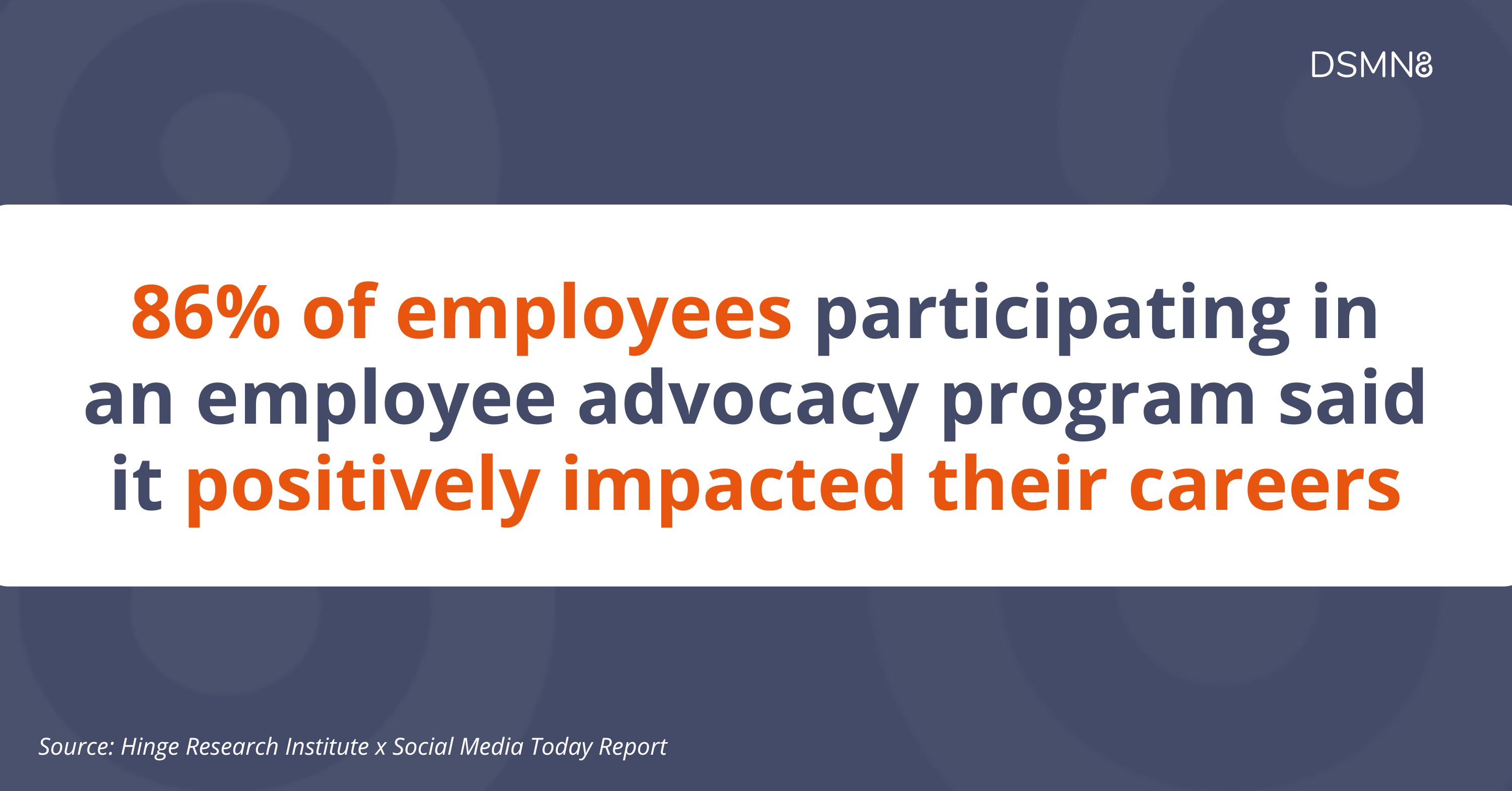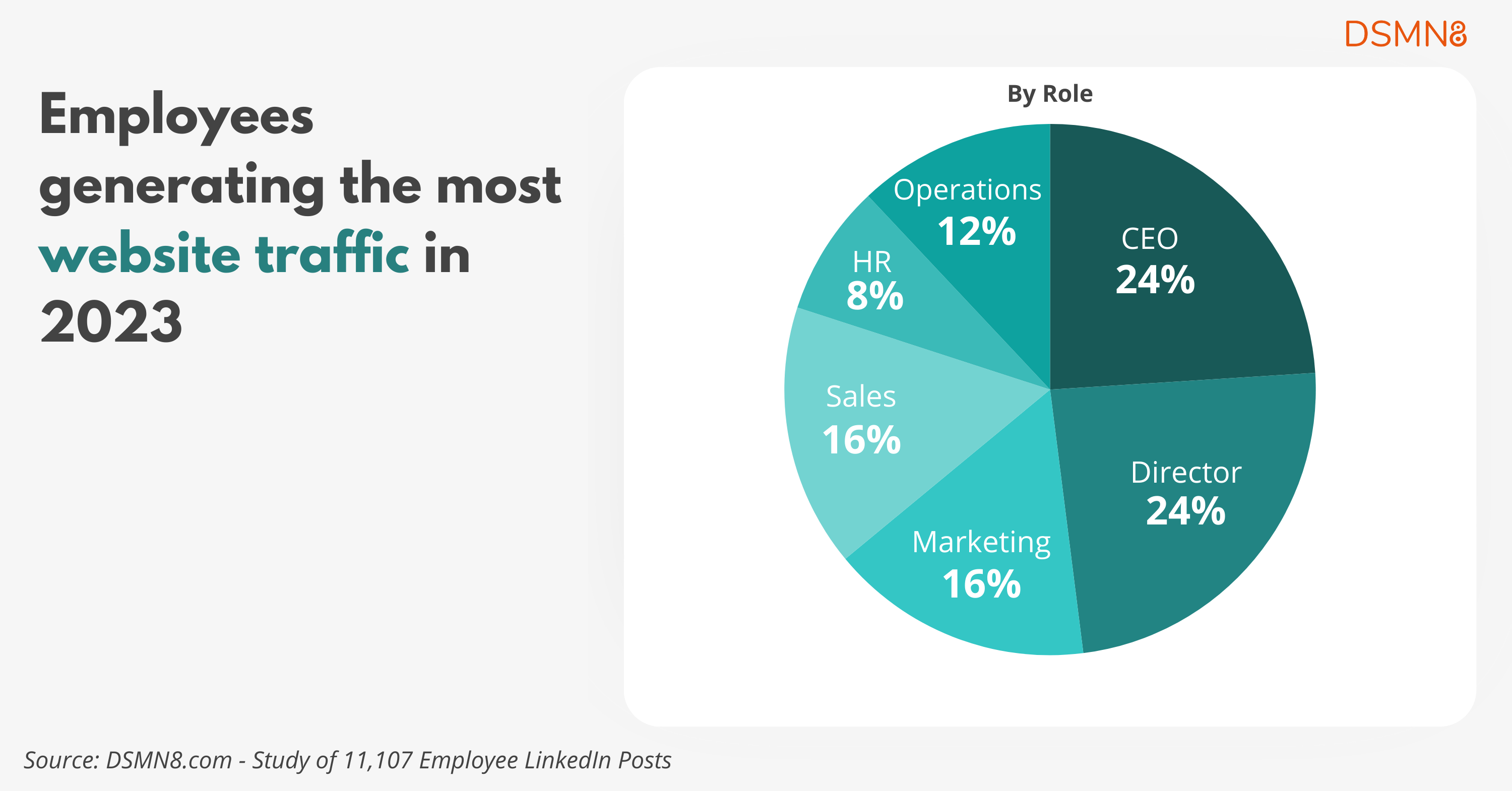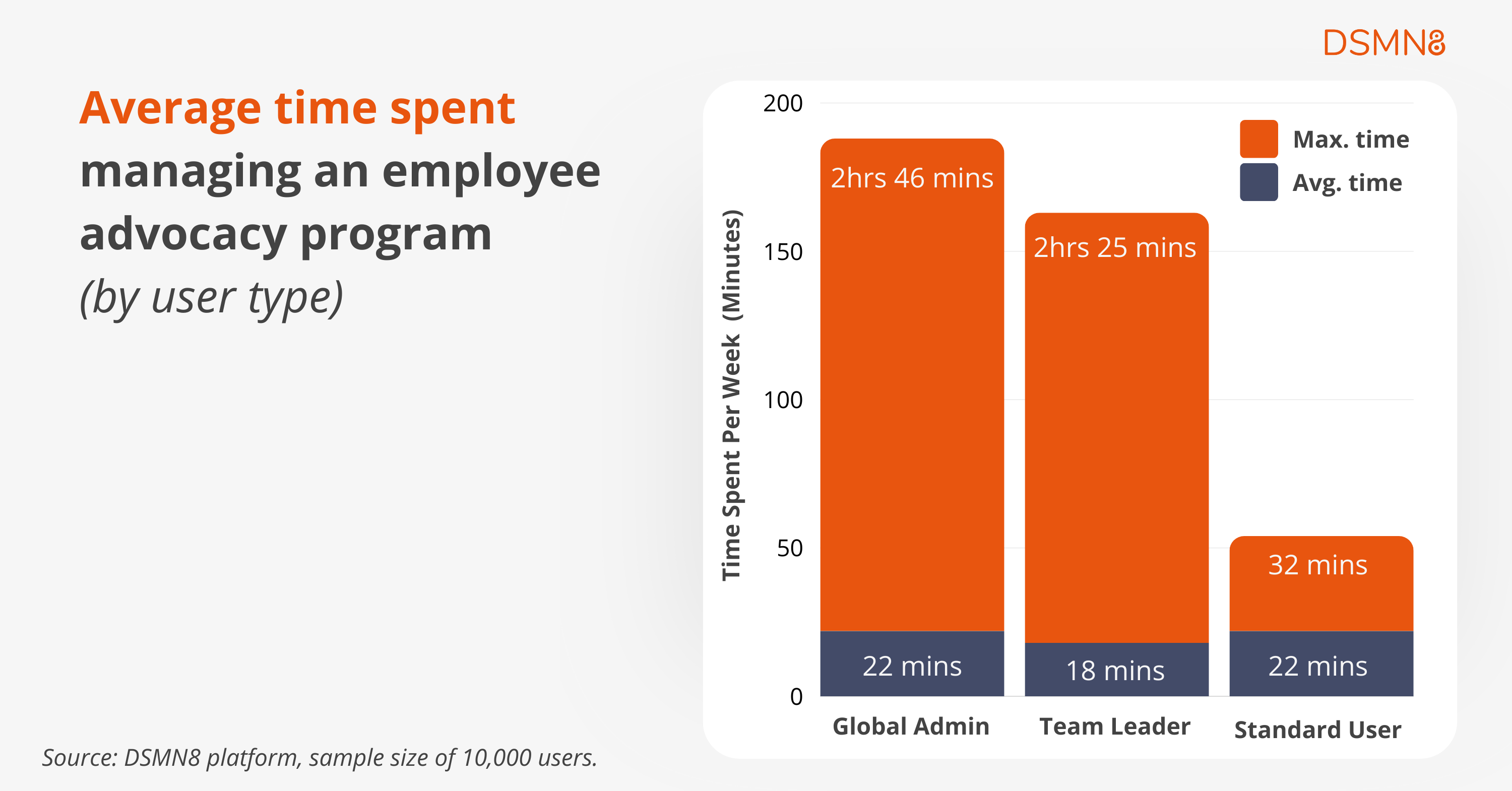
Last updated: 10th Dec 2024.
Employee advocacy programs are steadily on the rise, especially in the B2B sector.
But is it just another social media marketing trend? 🤔
We believe it’s here to stay.
We’ve been banging the drum about employee advocacy as a marketing, social selling, and employer branding strategy for years now.
It’s an initiative that contributes to a variety of business objectives, from establishing a cost-efficient marketing and sales strategy, to recruiting top talent and increasing employee engagement.
The results our clients have achieved are incredible, all through the power of employee influence on social media.
With more and more marketers choosing employee advocacy, today we’re sharing the stats to reveal why.
Let’s dive into the data 👇
Social Media Statistics
Employee advocacy as a concept isn’t new. It developed from traditional word-of-mouth marketing. These days, it largely takes place on social media, so we’ll start with some social media statistics.
How many people actually use social media?
Research by Statista revealed that the number of social media users reached 5.22 billion worldwide in October 2024. They estimate this number to reach over 6 billion by 2027.
That’s a lot of people.
In fact, 63.8% of the world’s population uses social media, according to Data Reportal.
And the average time people spend on social media every day is 2 hours, 24 minutes in 2024.
So, more than half of the world hangs out on social media on a daily basis.
And they spend a lot of time scrolling. But…
How effective is social media for marketing?
Well, according to Hubspot’s 2024 State of Marketing Report, social media is the highest ROI marketing channel.
And Nielsen’s 2024 Global Annual Marketing Report revealed that 72% of marketing teams expect bigger ad budgets in 2025.

Are people interested in brand content?
Absolutely!
78% of internet users look for information about brands on social media. [GWI]
76% of consumers ‘always’ or ‘regularly’ read online reviews when browsing for local businesses. [BrightLocal]
54% of C-Suite executives spend an hour or more reading thought leadership content every week. [LinkedIn & Edelman]
It’s clear that businesses’ online reputations, from corporate social media channels to user-generated content like customer reviews, has a significant impact on sales in both B2B and B2C sectors.
Employee Advocacy Statistics for 2025
Technology researchers at Gartner predicted that by the end of 2023, ‘90% of B2B social media marketing strategies will incorporate scaled employee advocacy programs’.
Yep, you read that correctly – 90%.
While we can’t confirm if that prediction came true…
We can say that the Employee Advocacy Benchmark Report revealed that program managers plan to scale employee advocacy in 2025: 73% will encourage leadership involvement, and 67% will provide comprehensive training and resources to employee advocates.
Which social media platform works best for employee advocacy?
Well, 82% of B2B marketers report finding the greatest success on LinkedIn.
Plus, over 46% of all social media traffic to company websites comes from LinkedIn!
The opportunity for employee advocacy and B2B marketing on LinkedIn is growing rapidly. In 2024, they have more than a billion members in over 200 countries!
What kind of social media content is popular in 2024 and will be in 2025?
Short-form video has dominated social media over the past few years and is showing no signs of slowing down.
With the huge success of TikTok, other social media networks have followed suit, even LinkedIn.
51% of social media users say they’ve watched a short video (under 10 minutes) in the last week. [GWI]
A report by Wyzowl revealed that 91% of businesses used video as part of their marketing strategy in 2024.
And 68% of those who weren’t already leveraging video plan to do so next year.
According to Hootsuite’s Social Media Trends 2025 report, marketers are doubling down on AI, with a 95% increase in using AI tools to revise or rewrite copy.
How do employees feel about sharing company content on social media?
According to Hinge Research Institute, 86% of employees participating in an employee advocacy program said it positively impacted their careers 🙌
DSMN8’s Employee Advocacy Benchmark Report 2025 revealed that this number has only increased, with 96% of employees saying they believe posting on social media has benefitted their careers.
And LinkedIn data revealed that employees are 14 times more likely to share content created by their company than any other type of content on the platform.
As 68% of companies already work with social media influencers, and employees are eager to get involved…
It’s time to think about empowering your team to become in-house influencers and content creators.

How much time is required for managing an employee advocacy program?
In a sample size of 10,000 DSMN8 platform users over a 12 month period, our data revealed how much time is generally invested into managing an employee advocacy program.
- Global Admin: 22 minutes per week average (highest week: 2 hrs 46 minutes)
- Team Leader: 18 minutes per week average (highest week: 2 hrs 25 minutes)
- Standard User: 22 minutes per week average (highest week: 32 minutes)
A common concern that department heads and senior leadership have when considering an employee advocacy strategy is the amount of time required by employees.
However, our figures show that the average advocate only needs to spend around 22 minutes per week using DSMN8 to maintain their social media presence.
Our data shows that admin users typically spent the most time during the first three months (up to 60 minutes per week).
Once your program is fully launched, your advocates are onboarded, and curating content becomes a regular cadence, this time reduces to an average of 20-30 minutes per week.
Learn more about the life of an employee advocacy program manager.
Which employees drive the most results from employee advocacy?
We analyzed 11,107 employee LinkedIn posts from 2023, and the results were clear: executive influence is huge.
In fact, the CEO of a civil engineering organization generated the same level of LinkedIn engagement with under 5,000 followers as the company page with over 300,000 followers.
That’s the same results, with 98% fewer followers.
Plus, 9/10 of this organization’s most ‘reacted to’ content was by the CEO. Getting buy-in from leadership makes a huge difference in the success of your program.

When it comes to driving website traffic, the same study of 11 thousand employee posts further emphasized the impact that the CEO and other senior executives can have, both driving 24% of advocacy program traffic to the organization’s site.
Sales and Marketing were the second highest, with each teams generating 16% of the program’s traffic. This was followed by Operations at 12% and HR at 6%.
The key takeaway here is that your advocacy program shouldn’t be limited to just folk who typically use social media for work, i.e. sales and marketing.

Social Selling Statistics
How does employee advocacy increase sales?
Building a personal brand on social media and sharing thought leadership content is the best way to boost social selling.
Did you know that salespeople who use social media to sell are 51% more likely to hit their sales quotas over their peers who don’t? [LinkedIn]
How can I reach decision-makers on social media?
Edelman & LinkedIn’s 2024 B2B Thought Leadership report revealed that:
“75% of decision-makers and C-Suite executives say that a piece of thought leadership has led them to research a product or service they were not previously considering.”
Oh, and that’s not all.
Employee advocacy programs help shorten the sales cycle.
According to Hinge Marketing, around 64% of employees in formal programs credit employee advocacy with attracting and developing new business.
Plus 45% attribute new revenue streams to their employee advocacy program.
Did you know that 83% of a typical B2B purchase decision happens before the customer actually engages with a brand or its salespeople? This is why the content your employees share on social media is so fundamental.
Decision-makers actively seek out thought leadership on LinkedIn
Edelman reported that 61% of decision-makers say that thought leadership content is more effective at demonstrating potential value of products/services than traditional product marketing.
And there are 65 million decision-makers and 10 million corporate executives currently using LinkedIn.
4 out of 5 LinkedIn users drive business decisions, so content shared by your employees has the potential to create huge impact for your organization.
Recruitment Statistics
We’ve given you the stats about social media, employee advocacy and social selling.
Now, let’s talk about recruitment.
Following the great resignation, recruitment has become more challenging over the past few years.
This is how an employee advocacy program can help your organization reach top talent:

How does employee advocacy support recruiters?
LinkedIn say that companies with a ‘high number of employees sharing high-quality content and thought leadership’ are 58% more likely to attract talent.
And according to Glassdoor, 79% of job applicants use social media in their job search, and 61 million people are using LinkedIn for job hunting each week.
These numbers are only likely to grow as social media usage and remote work increases globally.
Employee-generated content demonstrates your company culture and values, and humanizes your brand, making potential recruits more likely to apply to work for you.
The Takeaway
As you can see from the statistics we’ve shared above, employee advocacy programs have become much more mainstream over recent years, and are continuing to grow.
Social media is now an integral part of modern life, and its users are rapidly increasing every single day.
From looking for a new product or service to finding a new job: people will find your brand on social media.
For B2B marketing, employer branding, and social selling in 2025…
LinkedIn is the place to be.
Empowering employees to build personal brands, and your executives to create thought leadership content will make your company stand out from the crowd and generate tangible business results.
The key benefits of employee advocacy, according to the data:
- Getting more eyes on your content, and crucially, reaching the right people.
- Drastically reducing social media advertising spend.
- Showcasing your company culture to attract top talent.
- Establishing your social sellers as thought leaders.
- Enabling employees to develop new digital skills, and increasing employee engagement.
Ready to start an employee advocacy program that employees will actually want to participate in?
Emily Neal
SEO and Content Specialist at DSMN8. Emily has 10 years experience blogging, and is a pro at Pinterest Marketing, reaching 1 million monthly views. She’s all about empowering employees to grow their personal brands and become influencers.






